
|
Now it is 8.6 mag (Sept. 9, Michael Mattiazzo). It stays bright as 8-9 mag until early November. It will be observable in excellent condition in the Southern Hemisphere. It locates very low in the Northern Hemisphere.
Date(TT) R.A. (2000) Decl. Delta r Elong. m1 Best Time(A, h)
Sept.26 16 27.92 -25 17.2 1.399 1.353 66 8.8 19:15 ( 43, 15)
Oct. 3 16 54.22 -26 15.0 1.422 1.355 65 8.8 19:05 ( 41, 16)
|

|
It brightened rapidly. Now it is very bright as 9.4 mag (Sept. 26, Michael Mattiazzo). It will brighten up to 9 mag from October to November, and will be observable in excellent condition.
Date(TT) R.A. (2000) Decl. Delta r Elong. m1 Best Time(A, h)
Sept.26 4 9.43 -33 42.6 0.571 1.342 114 10.1 3:49 ( 0, 21)
Oct. 3 4 26.62 -31 34.3 0.526 1.312 114 9.8 3:39 ( 0, 23)
|

|
It approached to Sun down to 0.29 a.u. on July 3, and it brightened up to 0.6 mag (Alan Hale). Now it is fading. It has already faded down to 9.8 mag (Sept. 13, Katsumi Yoshimoto). It stays observable in the evening sky until early October when it fades down to 11 mag.
Date(TT) R.A. (2000) Decl. Delta r Elong. m1 Best Time(A, h)
Sept.26 14 58.92 -11 9.7 2.472 1.864 42 10.7 19:15 ( 69, 10)
Oct. 3 15 6.99 -12 41.1 2.665 1.977 38 11.1 19:05 ( 69, 7)
|

|
Now it is 13.2 mag (Sept. 20, Michael Mattiazzo). Although it is a tiny comet, it will approach to Sun down to 0.34 a.u. on Oct. 20, and it is expected to brighten up to 8.5 mag. It will be unobservable soon even in the Southern Hemisphere. In the Northern Hemisphere, it will appear in the morning sky at 10 mag in late October. Then it stasy observable while the comet will be fading rapidly. In the Southern Hemipshere, it will never be observable again.
Date(TT) R.A. (2000) Decl. Delta r Elong. m1 Best Time(A, h)
Sept.26 12 31.45 -47 2.3 0.810 0.730 46 12.2 19:15 ( 54,-35)
Oct. 3 12 31.99 -39 16.2 0.728 0.585 35 11.0 4:32 (298,-34)
|

|
Now it is 11.2 mag (Sept. 11, Carlos Labordena). It will be unobservable in early October.
Date(TT) R.A. (2000) Decl. Delta r Elong. m1 Best Time(A, h)
Sept.26 14 47.26 -5 50.8 3.161 2.466 39 11.6 19:15 ( 75, 11)
Oct. 3 14 56.80 -8 1.6 3.283 2.530 35 11.8 19:05 ( 74, 8)
|
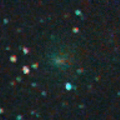
|
It brightened up to 14.2 mag in August (Aug. 18, Alan Hale). It approached to Sun down to 0.47 a.u. in September, and it was expected to brighten up to 11 mag. But actually, it was fainter than predicted. It is not observable after this.
Date(TT) R.A. (2000) Decl. Delta r Elong. m1 Best Time(A, h)
Sept.26 10 53.35 -3 39.6 1.382 0.552 19 12.1 4:26 (272, -3)
Oct. 3 11 27.31 -4 48.9 1.535 0.652 17 13.1 4:32 (273, -4)
|

|
Now it is 12.5-13.0 mag (Sept. 19, Michael Jager). It is very bright as 11.3 mag visually (Sept. 12, Carlos Labordena). It stays observable in excellent condition in the Northern Hemipshere. In the Southern Hemipshere, it is not obserbvable until early October.
Date(TT) R.A. (2000) Decl. Delta r Elong. m1 Best Time(A, h)
Sept.26 23 27.68 67 25.3 0.731 1.456 113 12.5 22:49 (180, 58)
Oct. 3 21 17.16 56 18.2 0.780 1.502 114 12.7 20:22 (180, 70)
|

|
It brightened up to 13.5 mag in summer (July 31, Ken-ichi Kadota). Now it is not observable. It is expected to brighten up to 12 mag from autumn to winter. In the Southern Hemisphere, it will appear in the morning sky in December, then it stays observable in good condition. In the Northern Hemisphere, it will be observable in the extremely low sky only from November to December.
Date(TT) R.A. (2000) Decl. Delta r Elong. m1 Best Time(A, h)
Sept.26 12 53.81 12 9.4 2.850 1.914 17 13.2 19:15 (106, -2)
Oct. 3 13 0.16 8 48.6 2.830 1.875 14 13.2 19:05 (105, -6)
|

|
Now it is 14.1 mag (Sept. 22, S. Shurpakov).
Date(TT) R.A. (2000) Decl. Delta r Elong. m1 Best Time(A, h)
Sept.26 2 49.95 27 33.8 5.087 5.826 133 13.3 2:31 ( 0, 83)
Oct. 3 2 47.74 27 34.3 5.018 5.828 140 13.2 2:01 ( 0, 83)
|
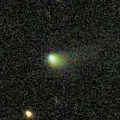
|
Now it is 15.3 mag (Sept. 12, SONEAR Observatory, Oliveira). It stays 13-14 mag from 2020 to 2021. It will be unobservable soon.
Date(TT) R.A. (2000) Decl. Delta r Elong. m1 Best Time(A, h)
Sept.26 14 12.40 -5 19.7 3.795 2.975 30 14.4 19:15 ( 80, 4)
Oct. 3 14 22.28 -6 33.5 3.828 2.965 26 14.4 19:05 ( 80, 2)
|
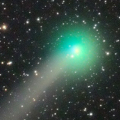
|
It brightened up to 6.0 mag in June (June 13, Marco Goiato). Now it is fading. It has already faded down to 13.0 mag (Sept. 21, Seiichi Yoshida). It stays observable in good condition for a long time after this.
Date(TT) R.A. (2000) Decl. Delta r Elong. m1 Best Time(A, h)
Sept.26 16 13.76 23 0.8 2.084 1.869 63 14.6 19:15 ( 89, 45)
Oct. 3 16 29.90 23 1.7 2.199 1.958 62 15.1 19:05 ( 89, 44)
|
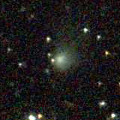
|
Now it is 15.0 mag (Sept. 20, Hiroshi Abe). It is expected to be observable at 5-6 mag for a long time from 2022 to 2023. In the Northern Hemisphere, it is not observable at the high light from 2022 summer to 2023 summer. In the Southern Hemisphere, it is only visible in the extremely low sky in summer in 2020. But it will be observable in good condition at the high light.
Date(TT) R.A. (2000) Decl. Delta r Elong. m1 Best Time(A, h)
Sept.26 17 5.70 43 19.7 8.312 8.180 79 14.7 19:15 (117, 60)
Oct. 3 17 7.16 42 24.2 8.303 8.127 76 14.7 19:05 (116, 57)
|

|
Now it is 14.2 mag (Sept. 15, Thomas Lehmann). It stays 14 mag until autumn. In the Southern Hemisphere, it will never be observable again.
Date(TT) R.A. (2000) Decl. Delta r Elong. m1 Best Time(A, h)
Sept.26 14 20.90 69 34.4 4.508 4.341 74 14.8 19:15 (155, 36)
Oct. 3 14 33.02 68 0.2 4.539 4.384 74 14.8 19:05 (153, 36)
|
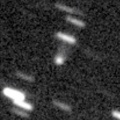
|
Now it is 16.1 mag (Sept. 3, Blue Mountains Observatory, Leura). It will brighten up to 13 mag in 2021. In the Southern Hemisphere, it stays observable at 15 mag until October. In the Northern Hemisphere, it is not observable until July in 2022.
Date(TT) R.A. (2000) Decl. Delta r Elong. m1 Best Time(A, h)
Sept.26 14 21.97 -30 37.5 5.012 4.329 42 14.9 19:15 ( 58, -9)
Oct. 3 14 28.03 -31 33.7 5.039 4.296 38 14.8 19:05 ( 59,-11)
|
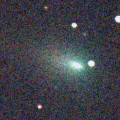
|
Recovered from SWAN images after 24-year blank. It brightened up to 10.2 mag in spring (May 31, Marco Goiato). Now it is fading very rapidly. It has already faded down to 18.0 mag (Sept. 12, M. Jaeger, E. Prosperi, S. Prosperi).
Date(TT) R.A. (2000) Decl. Delta r Elong. m1 Best Time(A, h)
Sept.26 7 0.12 9 9.9 1.884 1.945 78 14.9 4:26 (302, 50)
Oct. 3 7 8.78 8 26.3 1.859 1.996 82 15.1 4:32 (310, 54)
|
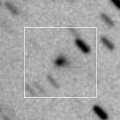
|
Now it is 15 mag (Sept. 11, Giuseppe Pappa). It will brighten up to 12 mag in winter in 2022. In the Northern Hemisphere, it stays observable in good condition for a long time. In the Southern Hemisphere, it is not observable until 2021 November.
Date(TT) R.A. (2000) Decl. Delta r Elong. m1 Best Time(A, h)
Sept.26 0 33.55 65 43.8 4.927 5.432 115 15.0 0:15 (180, 59)
Oct. 3 0 27.14 65 51.3 4.846 5.390 118 14.9 23:36 (180, 59)
|
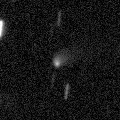
|
Now it is 15.0 mag (Aug. 28, Chris Wyatt). It stays 14-15 mag until 2021. In the Southern Hemisphere, it stays observable in good condition for a long time. In the Northern Hemisphere, it is not observable until June in 2021.
Date(TT) R.A. (2000) Decl. Delta r Elong. m1 Best Time(A, h)
Sept.26 17 3.05 -72 39.6 4.570 4.572 83 15.2 19:15 ( 11,-21)
Oct. 3 17 20.98 -71 39.3 4.613 4.553 80 15.2 19:05 ( 12,-20)
|

|
Now it is 15.4 mag (Sept. 21, Slooh.com Chile Observatory, La Dehesa). It will brighten up to 13.5 mag in spring in 2021. In the Southern Hemisphere, it stays observable in good condition for a long time. In the Northern Hemisphere, it is not observable until spring in 2021.
Date(TT) R.A. (2000) Decl. Delta r Elong. m1 Best Time(A, h)
Sept.26 17 20.24 -55 13.3 3.869 3.855 81 15.3 19:15 ( 19, -5)
Oct. 3 17 16.55 -53 40.6 3.957 3.824 75 15.3 19:05 ( 22, -5)
|

|
Now it is 15.5 mag (Sept. 19, M. Jaeger, E. Prosperi, S. Prosperi). It stays 15.5 mag from summer to winter, and observable in good condition. It locates somewhat low in the Southern Hemisphere.
Date(TT) R.A. (2000) Decl. Delta r Elong. m1 Best Time(A, h)
Sept.26 7 37.34 18 41.0 2.118 2.012 70 15.4 4:26 (282, 49)
Oct. 3 7 49.27 18 24.7 2.076 2.044 74 15.3 4:32 (287, 53)
|

|
It was expected to brighten very rapidly, and brighten up to 14.5 mag from August to September. However, its current brightness is very uncertain. It could not be detected as fainter than 18.0 mag on June 30 (Charles S. Morris), and fainter than 15.7 mag on July 13 (Sandor Szabo). However, Giuseppe Pappa reported as 14 mag on July 10, and Thomas Lehmann reported it is bright as 15.2 mag on July 12. In the Northern Hemisphere, it stays observable for a long time. In the Southern Hemisphere, it is not observable until late October.
Date(TT) R.A. (2000) Decl. Delta r Elong. m1 Best Time(A, h)
Sept.26 10 48.37 22 43.6 1.776 1.057 31 15.5 4:26 (251, 12)
Oct. 3 10 49.49 18 11.8 1.788 1.117 34 15.7 4:32 (259, 16)
|
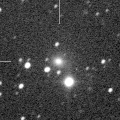
|
It brightened up to 13.5 mag in winter (Dec. 6, Chris Wyatt). Now it is fading slowly. Now it is 14.6 mag (Sept. 20, Katsumi Yoshimoto). In the Southern Hemisphere, it stays observable for a long time. It locates somewhat low in the Northern Hemisphere. Taras Prystavski found its fragmentation on Sept. 12.
Date(TT) R.A. (2000) Decl. Delta r Elong. m1 Best Time(A, h)
Sept.26 2 45.82 -38 5.1 3.692 4.369 126 15.7 2:27 ( 0, 17)
Oct. 3 2 36.61 -38 5.2 3.701 4.407 129 15.8 1:50 ( 0, 17)
|

|
Now it is 15.7 mag (Sept. 11, Thomas Lehmann). It stays 15-16 mag for a long time until 2021.
Date(TT) R.A. (2000) Decl. Delta r Elong. m1 Best Time(A, h)
Sept.26 18 28.77 19 34.0 4.360 4.550 94 15.8 19:15 ( 49, 68)
Oct. 3 18 26.70 19 22.2 4.467 4.560 88 15.8 19:05 ( 57, 65)
|
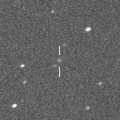
|
Now it is 15.1 mag (Sept. 22, S. Shurpakov). It will brighten up to 14.5 mag from spring to summer in 2021. In the Southern Hemisphere, it stays observable in excellent condition for a long time. In the Northern Hemisphere, it is observable in good condition in 2020, however, it will be unobservable in 2021.
Date(TT) R.A. (2000) Decl. Delta r Elong. m1 Best Time(A, h)
Sept.26 21 49.55 -16 58.0 2.574 3.408 140 15.9 21:26 ( 0, 38)
Oct. 3 21 40.84 -19 19.5 2.624 3.365 130 15.9 20:50 ( 0, 36)
|

|
Now it is 15.3 mag (Aug. 28, Chris Wyatt). It brightens up to 16 mag from summer to winter. In the Southern Hemisphere, it is observable in excellent condition. In the Northern Hemisphere, it is not observable until late October.
Date(TT) R.A. (2000) Decl. Delta r Elong. m1 Best Time(A, h)
Sept.26 20 44.84 -61 11.6 0.905 1.528 106 16.0 20:23 ( 0, -6)
Oct. 3 20 48.76 -57 42.4 0.894 1.489 103 15.9 20:00 ( 0, -2)
|

|
Now it is 15.3 mag (Sept. 9, M. Jaeger, E. Prosperi, S. Prosperi). It will stay at 15 mag for a long time from 2021 to 2022. In the Northern Hemisphere, it stays observable in good condition while brightening gradually. In the Southern Hemisphere, it stays locating low for a long time.
Date(TT) R.A. (2000) Decl. Delta r Elong. m1 Best Time(A, h)
Sept.26 17 27.74 17 57.5 5.945 5.856 80 16.0 19:15 ( 68, 57)
Oct. 3 17 27.89 16 38.0 6.011 5.829 74 16.1 19:05 ( 70, 53)
|
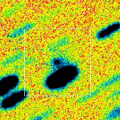
|
Now it is 17.2 mag (Aug. 17, P. Camilleri, H. Williams). It brightens up to 15 mag in winter. But it is not observable at high light. In the Southern Hemisphere, it stays observable in good condition until autumn when the comet will brighten up to 16 mag. It stays locating very low in the Northern Hemisphere.
Date(TT) R.A. (2000) Decl. Delta r Elong. m1 Best Time(A, h)
Sept.26 18 19.55 -33 18.1 2.119 2.360 91 16.2 19:15 ( 17, 19)
Oct. 3 18 28.56 -32 10.0 2.179 2.337 86 16.1 19:05 ( 19, 20)
|

|
Now it is 15.7 mag (Sept. 23, ATLAS-MLO, Mauna Loa). It is expected to brighten up to 16 mag from October to November, and it will be observable in excellent condition.
Date(TT) R.A. (2000) Decl. Delta r Elong. m1 Best Time(A, h)
Sept.26 23 53.05 -35 25.5 0.535 1.466 143 16.3 23:30 ( 0, 20)
Oct. 3 23 45.42 -33 1.6 0.511 1.435 141 16.1 22:54 ( 0, 22)
|
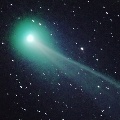
|
It brightened up to 4.7 mag in early May (May 2, Marco Goiato). However, it has faded and got diffused after that. It seems to have already disappeared. It stays observable in good condition after this.
Date(TT) R.A. (2000) Decl. Delta r Elong. m1 Best Time(A, h)
Sept.26 6 38.18 6 2.2 2.236 2.344 83 16.1 4:26 (312, 51)
Oct. 3 6 32.67 3 58.3 2.208 2.444 91 16.3 4:32 (327, 55)
|

|
Now it is 15.9 mag (Sept. 16, J. Drummond). It is observable at 15-16 mag in 2020. It is observable in excellent condition in the Southern Hemisphere. It locates somewhat low in the Northern Hemisphere.
Date(TT) R.A. (2000) Decl. Delta r Elong. m1 Best Time(A, h)
Sept.26 18 0.92 -25 12.2 6.888 6.911 87 16.2 19:15 ( 24, 26)
Oct. 3 17 59.79 -24 51.8 7.031 6.928 79 16.2 19:05 ( 28, 24)
|
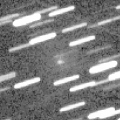
|
Now it is 15.0-15.5 mag (Sept. 19, Michael Jager). It will approach to Sun down to 0.4 a.u. on Dec. 13, and it is expected to brighten up to 9.5 mag. It stays observable while the comet is brightening until late November when it brightens up to 10 mag.
Date(TT) R.A. (2000) Decl. Delta r Elong. m1 Best Time(A, h)
Sept.26 8 4.10 7 11.4 1.913 1.697 62 16.7 4:26 (290, 37)
Oct. 3 8 24.61 5 14.4 1.748 1.581 63 16.2 4:32 (294, 38)
|
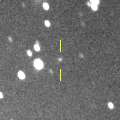
|
Now it is 15.9 mag (Apr. 24, J. Drummond). It is expected to brighten up to 13 mag in 2022. In 2020, it is observable in excellent condition in the Southern Hemisphere. In the Northern Hemisphere, it is observable from autumn to winter, but it locating extremely low.
Date(TT) R.A. (2000) Decl. Delta r Elong. m1 Best Time(A, h)
Sept.26 8 11.53 -30 20.5 6.898 6.516 63 16.3 4:26 (317, 9)
Oct. 3 8 15.65 -31 5.5 6.805 6.477 66 16.3 4:32 (323, 12)
|

|
Now it is 15.8 mag (Sept. 5, Thomas Lehmann). It stays observable until December when it becomes fainter than 18 mag.
Date(TT) R.A. (2000) Decl. Delta r Elong. m1 Best Time(A, h)
Sept.26 19 40.24 -11 58.8 1.534 2.117 111 16.3 19:19 ( 0, 43)
Oct. 3 19 49.46 -12 36.3 1.615 2.132 106 16.5 19:05 ( 1, 42)
|

|
Now it is 15.0-15.5 mag (Sept. 19, Michael Jager). It stays 16 mag until late September. It is observable in good condition in the Northern Hemisphere. It locates low in the Southern Hemisphere.
Date(TT) R.A. (2000) Decl. Delta r Elong. m1 Best Time(A, h)
Sept.26 7 46.58 21 45.4 1.362 1.363 68 16.4 4:26 (276, 49)
Oct. 3 8 6.07 21 7.0 1.357 1.396 70 16.6 4:32 (280, 51)
|
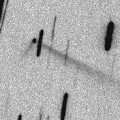
|
Now it is 17.5 mag (Aug. 15, Toshihiko Ikemura, Hirohisa Sato). Main-belt asteroid. But it showed a straight tail like a comet in 2019. In 2020, it brightens up to 16.5 mag and stays observable in good condition from September to October.
Date(TT) R.A. (2000) Decl. Delta r Elong. m1 Best Time(A, h)
Sept.26 0 19.83 1 34.2 1.275 2.277 177 16.5 0:01 ( 0, 57)
Oct. 3 0 14.23 -0 30.0 1.296 2.292 172 16.7 23:23 ( 0, 54)
|
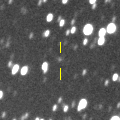
|
Now it is 16.5 mag (Sept. 11, Giuseppe Pappa). It is observable at 16.5-17 mag from 2020 to 2021. In the Southern Hemisphere, it is not observable until summer in 2021.
Date(TT) R.A. (2000) Decl. Delta r Elong. m1 Best Time(A, h)
Sept.26 23 15.33 72 51.0 5.666 6.049 107 16.6 22:51 (180, 52)
Oct. 3 22 57.75 71 41.6 5.617 6.040 110 16.6 22:06 (180, 53)
|
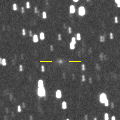
|
Now it is 16.8 mag (Sept. 14, Thomas Lehmann). It stays 16.5 mag until October, and observable in good condition.
Date(TT) R.A. (2000) Decl. Delta r Elong. m1 Best Time(A, h)
Sept.26 20 22.10 6 57.1 1.432 2.146 122 16.6 20:00 ( 0, 62)
Oct. 3 20 28.02 5 28.4 1.489 2.149 118 16.7 19:39 ( 0, 60)
|
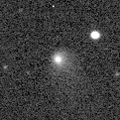
|
It brightened up to 13.8 mag in autumn in 2019 (Sept. 3, Chris Wyatt). Now it is fading slowly. Now it is 15.2 mag (Sept. 22, S. Shurpakov). In 2020, it stays observable in good condition while the comet will be fading from 16 to 17 mag.
Date(TT) R.A. (2000) Decl. Delta r Elong. m1 Best Time(A, h)
Sept.26 0 8.24 1 46.9 5.323 6.325 179 16.6 23:45 ( 0, 57)
Oct. 3 0 4.05 1 49.6 5.376 6.367 171 16.7 23:13 ( 0, 57)
|

|
First return of a new periodic comet which brightened up to 13 mag in 2009. Now it is 16.5 mag (Sept. 23, Mt. Lemmon Survey). It is expected to brighten up to 12 mag and to be observable in excellent condition in winter.
Date(TT) R.A. (2000) Decl. Delta r Elong. m1 Best Time(A, h)
Sept.26 3 31.20 -3 33.2 0.820 1.653 129 17.3 3:11 ( 0, 52)
Oct. 3 3 40.63 -4 52.7 0.749 1.609 133 16.7 2:53 ( 0, 50)
|

|
It passed the perihelion on June 25, and brightened up to 7.3 mag (June 30, Chris Wyatt). Now it is fading. It has already faded down to 15.7 mag (Sept. 7, Blue Mountains Observatory, Leura). In the Southern Hemisphere, it stays observable in good condition in the evening sky while the comet will be fading. It locates very low in the Northern Hemisphere.
Date(TT) R.A. (2000) Decl. Delta r Elong. m1 Best Time(A, h)
Sept.26 17 34.46 -30 45.0 1.539 1.708 81 16.9 19:15 ( 27, 18)
Oct. 3 17 53.44 -30 11.4 1.696 1.792 78 17.4 19:05 ( 27, 19)
|
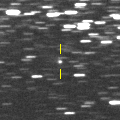
|
Now it is 16.6 mag (Sept. 19, D. Buczynski). It is observable at 16.5-17 mag from spring in 2020 to summer in 2021.
Date(TT) R.A. (2000) Decl. Delta r Elong. m1 Best Time(A, h)
Sept.26 17 17.04 4 46.4 4.772 4.643 76 16.9 19:15 ( 55, 46)
Oct. 3 17 16.19 3 26.6 4.881 4.639 70 16.9 19:05 ( 58, 42)
|
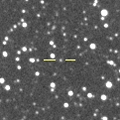
|
Now it is 16.6 mag (Sept. 19, M. Jaeger, E. Prosperi, S. Prosperi). It stays at 17 mag from 2020 to 2021.
Date(TT) R.A. (2000) Decl. Delta r Elong. m1 Best Time(A, h)
Sept.26 18 56.82 30 58.7 8.634 8.870 100 17.1 19:15 ( 67, 81)
Oct. 3 18 55.95 30 41.9 8.702 8.866 96 17.1 19:05 ( 75, 77)
|

|
First return of a new periodic comet which brightened up to 17.5 mag in 2012. Now it is 17.5 mag (Aug. 15, Toshihiko Ikemura, Hirohisa Sato). It stays observable at 17 mag in good condition from summer to winter. It locates somewhat low in the Southern Hemisphere.
Date(TT) R.A. (2000) Decl. Delta r Elong. m1 Best Time(A, h)
Sept.26 5 7.94 32 45.9 1.935 2.385 103 17.1 4:26 (295, 85)
Oct. 3 5 13.26 33 37.1 1.873 2.400 109 17.1 4:26 ( 0, 89)
|

|
New comet discovered in the images of SOHO spacecraft. It approached to Sun down to 0.09 a.u. on Aug. 8, and it brightened up to 3 mag. It will appear in the morning sky in October. But it must be fainter than 18 mag.
Date(TT) R.A. (2000) Decl. Delta r Elong. m1 Best Time(A, h)
Sept.26 10 38.92 -0 31.9 2.254 1.389 23 17.2 4:26 (272, 1)
Oct. 3 10 48.06 -1 36.7 2.346 1.526 27 17.7 4:32 (276, 5)
|

|
Now it is 18.2 mag (Sept. 17, D. Buczynski). It is expected to brighten up to 16 mag from autumn to winter. It is observable in excellent condition in the Northern Hemisphere. It locates somewhat low in the Southern Hemisphere.
Date(TT) R.A. (2000) Decl. Delta r Elong. m1 Best Time(A, h)
Sept.26 2 32.27 41 55.5 1.300 2.078 128 17.4 2:13 (180, 83)
Oct. 3 2 33.42 42 37.9 1.234 2.055 133 17.2 1:47 (180, 82)
|

|
Now it is 18.6 mag (Aug. 6, Palomar Mountain--ZTF). It will approach to Sun down to 0.14 a.u. on Dec. 7, and will brighten up to 11 mag. But it is not observable at the high light. It is observable until November when it brightens up to 16 mag.
Date(TT) R.A. (2000) Decl. Delta r Elong. m1 Best Time(A, h)
Sept.26 7 38.34 27 18.9 1.442 1.470 71 17.5 4:26 (270, 53)
Oct. 3 8 0.11 26 0.9 1.292 1.386 73 17.2 4:32 (273, 55)
|

|
It brightened up to 13.2 mag from spring to autumn in 2019 (June 30, Thomas Lehmann). Now it is fading slowly. It has already faded down to 16.2 mag (Sept. 11, Giuseppe Pappa). In the Southern Hemisphere, it stays observable for a long time. In the Northern Hemisphere, it stays low for a long time.
Date(TT) R.A. (2000) Decl. Delta r Elong. m1 Best Time(A, h)
Sept.26 22 37.49 -29 8.6 3.916 4.748 142 17.3 22:14 ( 0, 26)
Oct. 3 22 30.92 -28 27.9 4.022 4.789 135 17.4 21:40 ( 0, 27)
|
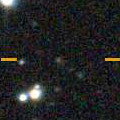
|
Now it is 17.4 mag (Sept. 18, E. Bryssinck). It will brighten up to 13.5 mag from winter to spring in 2021. In the Northern Hemisphere, it stays observable in excellent condition. In the Southern Hemisphere, it stays extremely low until 2021 spring.
Date(TT) R.A. (2000) Decl. Delta r Elong. m1 Best Time(A, h)
Sept.26 0 13.26 50 24.6 1.885 2.651 130 17.6 23:50 (180, 74)
Oct. 3 0 4.77 50 46.6 1.791 2.577 132 17.4 23:14 (180, 74)
|

|
Now it is 17.4 mag (Sept. 16, Blue Mountains Observatory, Leura). It will brighten up to 15.5 mag in early 2021. In 2020, it stays observable at 17 mag until November in the Southern Hemisphere. In the Northern Hemisphere, it stays unobservable until 2021 June.
Date(TT) R.A. (2000) Decl. Delta r Elong. m1 Best Time(A, h)
Sept.26 15 16.00 -30 29.7 2.937 2.460 52 17.5 19:15 ( 51, 0)
Oct. 3 15 28.67 -30 54.6 2.947 2.405 48 17.4 19:05 ( 52, -1)
|

|
It brightened up to 7.7 mag in June in 2018 (June 19, Juan Jose Gonzalez). Now it is fading. It has already faded down to 18.7 mag (Sept. 20, ATLAS-MLO, Mauna Loa). In the Southern Hemisphere, it stays observable for a long time. It will be observable in good condition after this also in the Northern Hemisphere.
Date(TT) R.A. (2000) Decl. Delta r Elong. m1 Best Time(A, h)
Sept.26 6 40.04 -11 36.0 7.755 7.693 82 17.5 4:26 (325, 36)
Oct. 3 6 39.92 -11 52.0 7.708 7.744 88 17.5 4:32 (334, 39)
|

|
Now it is 17.9 mag (Sept. 23, ATLAS-MLO, Mauna Loa). It stays 17.5 mag until November. It is observable in excellent condition in the Southern Hemisphere. It locates very low in the Northern Hemisphere.
Date(TT) R.A. (2000) Decl. Delta r Elong. m1 Best Time(A, h)
Sept.26 23 9.26 -35 23.0 2.297 3.137 140 17.5 22:46 ( 0, 20)
Oct. 3 23 6.17 -35 55.9 2.350 3.137 134 17.6 22:16 ( 0, 19)
|
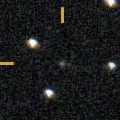
|
Now it is 17.6 mag (Sept. 20, A. Diepvens). It is observable at 17-18 mag for a long time from late 2019 to early 2021. It will fade out before it passes the perihelion.
Date(TT) R.A. (2000) Decl. Delta r Elong. m1 Best Time(A, h)
Sept.26 5 57.53 16 24.1 4.433 4.606 93 17.6 4:26 (315, 65)
Oct. 3 5 59.85 16 26.3 4.316 4.596 99 17.5 4:32 (331, 69)
|
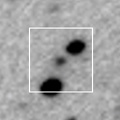
|
Now it is 17.6 mag (Sept. 21, A. Diepvens). It will approach to Earth down to 0.5 a.u. in November, and brighten up to 17 mag. It is observable in excellent condition.
Date(TT) R.A. (2000) Decl. Delta r Elong. m1 Best Time(A, h)
Sept.26 23 30.81 31 54.8 0.597 1.541 147 17.8 23:08 ( 0, 87)
Oct. 3 23 30.47 31 5.9 0.563 1.510 148 17.5 22:40 ( 0, 86)
|
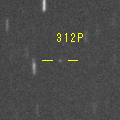
|
Now it is 18.4 mag (Sept. 7, ATLAS-MLO, Mauna Loa). It will brighten up to 17.5 mag in September. It is observable in excellent condition in the Southern Hemisphere. It locates somewhat low in the Northern Hemisphere.
Date(TT) R.A. (2000) Decl. Delta r Elong. m1 Best Time(A, h)
Sept.26 23 11.85 -24 11.5 1.047 1.983 150 17.6 22:49 ( 0, 31)
Oct. 3 23 11.18 -25 24.1 1.085 1.984 144 17.7 22:21 ( 0, 30)
|
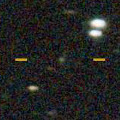
|
Now it is 17.3 mag (Sept. 16, Blue Mountains Observatory, Leura). It became brighter than orignally predicted. It will be fading after this, and will be fainter than 18 mag in October. It locates extremely low in the Northern Hemisphere.
Date(TT) R.A. (2000) Decl. Delta r Elong. m1 Best Time(A, h)
Sept.26 15 30.25 -24 5.1 2.530 2.090 53 17.6 19:15 ( 54, 7)
Oct. 3 15 46.49 -24 58.2 2.588 2.093 50 17.7 19:05 ( 53, 6)
|
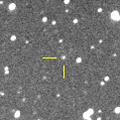
|
Now it is 17.2 mag (Sept. 13, E. Bryssinck). It was observed at 17 mag in 2019. In 2020, it is observable at 17.5 mag in good condition from summer to autumn.
Date(TT) R.A. (2000) Decl. Delta r Elong. m1 Best Time(A, h)
Sept.26 0 45.33 -7 12.4 2.792 3.778 168 17.7 0:26 ( 0, 48)
Oct. 3 0 40.87 -7 30.0 2.800 3.785 168 17.7 23:50 ( 0, 48)
|

|
It stays observable at 17 mag for a long time until 2027. In the Southern Hemipshere, it stays observable in good condition for a long time. It is not observable in the Northern Hemipsphere.
Date(TT) R.A. (2000) Decl. Delta r Elong. m1 Best Time(A, h)
Sept.26 10 0.29 -45 57.4 12.533 11.959 53 17.8 4:26 (315,-17)
Oct. 3 10 2.14 -46 31.1 12.499 11.940 54 17.8 4:32 (318,-13)
|

|
Now it is 17.7 mag (Sept. 14, Slooh.com Chile Observatory, La Dehesa). It will brighten up to 16.5 mag in 2021 summer. In the Southern Hemisphere, it stays observable for a while. In the Northern Hemisphere, it is not observable until 2021 February.
Date(TT) R.A. (2000) Decl. Delta r Elong. m1 Best Time(A, h)
Sept.26 15 6.24 -44 27.3 5.994 5.528 57 17.8 19:15 ( 42,-10)
Oct. 3 15 13.05 -43 48.7 6.053 5.504 52 17.8 19:05 ( 44,-11)
|

|
Now it is 18.1 mag (Sept. 20, Katsumi Yoshimoto). It will approach to Earth down to 0.46 a.u. in 2021 April, and it is expected to brighten up to 12.5 mag and to be observable in excellent condition.
Date(TT) R.A. (2000) Decl. Delta r Elong. m1 Best Time(A, h)
Sept.26 2 5.92 -8 32.9 1.634 2.551 149 18.1 1:47 ( 0, 47)
Oct. 3 1 42.73 -11 22.0 1.515 2.469 157 17.8 0:57 ( 0, 44)
|
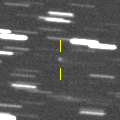
|
Now it is 17.4 mag (Sept. 5, ATLAS-MLO, Mauna Loa). It stays observable at 17.5-18 mag in good condition until winter.
Date(TT) R.A. (2000) Decl. Delta r Elong. m1 Best Time(A, h)
Sept.26 6 55.19 17 0.4 1.892 1.979 79 17.8 4:26 (294, 56)
Oct. 3 7 6.94 17 1.3 1.839 1.999 83 17.8 4:32 (300, 60)
|
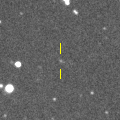
|
Now it is 17.3 mag (Sept. 5, Blue Mountains Observatory, Leura). It stays 18 mag from 2019 to 2020.
Date(TT) R.A. (2000) Decl. Delta r Elong. m1 Best Time(A, h)
Sept.26 20 48.04 -9 5.6 3.915 4.605 128 17.9 20:26 ( 0, 46)
Oct. 3 20 47.87 -9 26.4 4.005 4.607 121 18.0 19:58 ( 0, 46)
|
|
![]()
 C/2017 T2 ( PanSTARRS )
C/2017 T2 ( PanSTARRS ) C/2020 K8 ( Catalina-ATLAS )
C/2020 K8 ( Catalina-ATLAS ) C/2020 Q1 ( Borisov )
C/2020 Q1 ( Borisov ) C/2019 N1 ( ATLAS )
C/2019 N1 ( ATLAS ) 29P/Schwassmann-Wachmann 1
29P/Schwassmann-Wachmann 1 246P/NEAT
246P/NEAT C/2019 U6 ( Lemmon )
C/2019 U6 ( Lemmon ) C/2017 K2 ( PanSTARRS )
C/2017 K2 ( PanSTARRS ) C/2018 N2 ( ASASSN )
C/2018 N2 ( ASASSN ) C/2019 F1 ( ATLAS-Africano )
C/2019 F1 ( ATLAS-Africano ) 58P/Jackson-Neujmin
58P/Jackson-Neujmin C/2019 L3 ( ATLAS )
C/2019 L3 ( ATLAS ) C/2020 F5 ( MASTER )
C/2020 F5 ( MASTER ) C/2020 J1 ( SONEAR )
C/2020 J1 ( SONEAR ) 84P/Giclas
84P/Giclas C/2020 H4 ( Leonard )
C/2020 H4 ( Leonard ) C/2018 F4 ( PanSTARRS )
C/2018 F4 ( PanSTARRS ) C/2019 K7 ( Smith )
C/2019 K7 ( Smith ) C/2019 T2 ( Lemmon )
C/2019 T2 ( Lemmon ) 162P/Siding Spring
162P/Siding Spring C/2018 U1 ( Lemmon )
C/2018 U1 ( Lemmon ) 17P/Holmes
17P/Holmes 156P/Russell-LINEAR
156P/Russell-LINEAR C/2020 F8 ( SWAN )
C/2020 F8 ( SWAN ) C/2017 U7 ( PanSTARRS )
C/2017 U7 ( PanSTARRS ) C/2020 S3 ( Erasmus )
C/2020 S3 ( Erasmus ) C/2019 T4 ( ATLAS )
C/2019 T4 ( ATLAS ) 115P/Maury
115P/Maury 304P/Ory
304P/Ory (6478) Gault
(6478) Gault C/2019 T3 ( ATLAS )
C/2019 T3 ( ATLAS ) 257P/Catalina
257P/Catalina C/2017 B3 ( LINEAR )
C/2017 B3 ( LINEAR ) P/2020 P2 ( Boattini )
P/2020 P2 ( Boattini ) 2P/Encke
2P/Encke C/2017 Y2 ( PanSTARRS )
C/2017 Y2 ( PanSTARRS ) C/2019 O3 ( Palomar )
C/2019 O3 ( Palomar ) P/2020 M2 ( Lemmon )
P/2020 M2 ( Lemmon ) C/2020 P4 ( SOHO )
C/2020 P4 ( SOHO ) 277P/LINEAR
277P/LINEAR (3200) Phaethon
(3200) Phaethon C/2018 A6 ( Gibbs )
C/2018 A6 ( Gibbs ) C/2020 N1 ( PanSTARRS )
C/2020 N1 ( PanSTARRS ) 28P/Neujmin 1
28P/Neujmin 1 C/2016 M1 ( PanSTARRS )
C/2016 M1 ( PanSTARRS ) 254P/McNaught
254P/McNaught 173P/Mueller 5
173P/Mueller 5 11P/Tempel-Swift-LINEAR
11P/Tempel-Swift-LINEAR 312P/NEAT
312P/NEAT 278P/McNaught
278P/McNaught 215P/NEAT
215P/NEAT C/2019 E3 ( ATLAS )
C/2019 E3 ( ATLAS ) C/2020 O2 ( Amaral )
C/2020 O2 ( Amaral ) C/2020 R4 ( ATLAS )
C/2020 R4 ( ATLAS ) 178P/Hug-Bell
178P/Hug-Bell P/2019 LD2 ( ATLAS )
P/2019 LD2 ( ATLAS )![]()












































